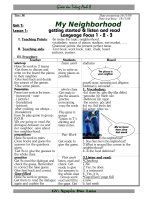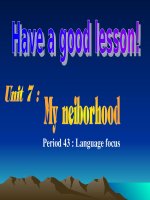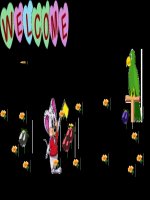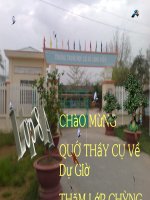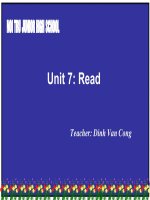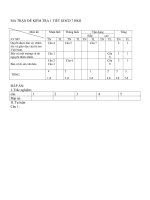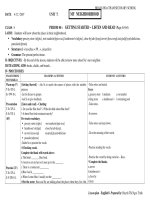TA 8 Unit 7 (tiết 55-61)
Bạn đang xem bản rút gọn của tài liệu. Xem và tải ngay bản đầy đủ của tài liệu tại đây (275.85 KB, 15 trang )
Trường THCS Mai Thị Hồng Hạnh
Week: 20
Period: 55
Tiếng Anh 8 thí điểm
Date of preparation: 02/01/16
Date of teaching: 05/01/16
UNIT 7: POPULATION
GETTING STARTED
I. OBJECTIVES:
1. Formation of behavior: By the end of the lesson, Ss can:
- listen and read for specific information about water and air population.
- practice listening and speaking with the lexical items related to the topic "Population".
2. Knowledge:
a. Vocabulary: The lexical items related to the topic “Population”
b. Grammar: Conditional sentences (type 1: review and type 2)
3. Skills: listening, speaking, reading, writing
II. PREPARATION:
1. Teacher: - Materials: Ss’ books, text books
- Method: group work, pair work, individual work
2. Ss: vocabulary
III. PROCEDURES:
1. Class order: Greetings, checking attendance, asking the date
2. Checking up: No
3. New lesson:
Teacher’s activities
Students’ activities
Content
- Divide the class into - Prepare in 2 min then Warm-up: Who is quicker?
groups of 4 students
tick/hang their
cardboards on the
board (The group that
What problems are
there near your
has more items than
home village?
the others win the
game.)
- Have Ss look at the - Look at the picture
picture on page 6 then on page 6 then answer
answer the questions.
the questions.
- Use some techniques
to present the new
words
- Checking: Rub out &
Remember
- Set the scense
- Play the recording
twice
- Have Ss work indivi.
To read the dialogue
and find.
- Compare the answers
- Repeat in chorus and
individually
- Copy all the new
words
- Listen and repeat
then rewrite the
missing words
- Listen to the T and
the tape
- Work individually
- Pair work
Questions:
- Can you guess who they are?
- Where are they?
- What can you see in the air?
a. Presentation:
New words:
- poison (n): chất độc
- aquatic (adj): dưới nước
- illustrate (v): minh họa
- radioactive (adj): thuộc về phóng xạ
- thermal (adj): thuộc về nhiệt
- visual (adj): thuộc về thị giác
b. Practice:
1. Listen and read.
- We are going to listen and read a
dialogue between Nick and Mi. They are
talking about a project on pollution.
a. Find the meaning of a word or a
phrase.
1. dead
2. aquatic
3. dump
4. poison
GV: Hồ Tấn Dũng – Năm học: 2015-2016
1
Trường THCS Mai Thị Hồng Hạnh
with your partner.
- Call on some Ss to
write their answers.
- Ask Ss to practice in
pairs
- Ask some Ss to
practise asking and
answering again
- Correct answers
- Ask Ss to discuss in
pairs
- Ask some Ss to stand
up and read the whole
sentence then say T, F
or NI
- Have Ss play the
game: What problem
is it?
- Divide the class into
2 groups
- Using: “one”,
“two”, “three” in
order to confirm the
priority.
- Tell the result.
5. polluted
- Pair work
b. Answer the questions.
1. They are in Mi’s home village.
- Some Ss stand up and 2. It's almost black.
practise asking and
3. Because she sees the fish are dead.
answering in pairs
4. It is dumping poison into the lake.
5. Because the air is not clean.
- Pair work
c. Tick true, false or no information (NI).
- Some Ss stand up and 1F
2T
3NI 4T
5T
give their answers
- Correct the mistakes
if yes
- Listen to the
instruction.
- Play the game in 2
groups
- The others listen
- Correct the mistakes
if yes
- Group work
- Ask Ss to discuss in
groups of 4
- Ask some groups to
present their types of
pollution
6. to come up with
- Correct the mistakes
- Pair work
- Ask Ss to practise in
pairs
- Ask some Ss to stand
up and read the whole
sentence
- Check and confirms
the correct answers
Tiếng Anh 8 thí điểm
- The others listen
2. Match the phrases with the pictures.
Rules of the game: “The leader of each
group leads the game. He or she can
choose a certain picture then reads it aloud.
The other team must give the correct
answer within 3 seconds. The team that
does not have the correct answer will lose 1
point.”
A. radioactive pollution B. noise pollution
C. visual pollution D. thermal pollution
E. water pollution F. land/ soil pollution
G. light pollution
H. air pollution
3. Complete the sentences with the types
of pollution.
1. thermal pollution
2. Air pollution
3. radioactive pollution 4. light pollution
5. water pollution
6. land/soil pollution
7. noise pollution
8. visual pollution
c. Production :
4. Work in groups. Which types of
pollution in 3 does your neighbourhood
face?
Rank them in order of seriousness. Give
reasons for your group’s order.
Vote for the group with the best reasons.
4. Homework:
- Complete the writing tasks in your notebook.
- Prepare: A closer look 1
Experience
......................................................................................................................................................
......................................................................................................................................................
......................................................................................................................................................
GV: Hồ Tấn Dũng – Năm học: 2015-2016
2
Trường THCS Mai Thị Hồng Hạnh
Week: 20
Period: 56
Tiếng Anh 8 thí điểm
Date of preparation: 02/01/16
Date of teaching: 05/01/16
UNIT 7: POPULATION
A CLOSER LOOK 1
I. OBJECTIVES:
1. Formation of behavior: By the end of the lesson, Ss can:
- use words and phrases showing cause/ effect relationships to describe the causes and effects of
pollution.
- pronounce the words ending in -ic and -al correctly in isolation and in context.
2. Knowledge:
a. Vocabulary: The lexical items related to the topic “Population”
b. Grammar: review
3. Skills: listening, speaking, reading, writing
II. PREPARATION:
1. Teacher: - Materials: Ss’ books, text books
- Method: group work, pair work, individual work
2. Ss: vocabulary
III. PROCEDURES:
1. Class order: Greetings, checking attendance, asking the date
2. Checking up: (5 ms) Types of pollution (Ask 4 Ss to go to the board and
divide them into 2 groups)
types of
T asks them to write types of pollution within one minute then checks
pollution
which group is better.
3. New lesson:
Teacher’s activities
Students’ activities
Content
- Ask Ss some Qs
- Listen and give out
Warm-up: Chatting
their answers.
Q: Why are the fish dead?
- Because of polluted water/water pollution ...
Q: Can we eat dead fish in this situation? Why
or why not?
- No, we can’t. Because they are poisonous.
a. Presentation:
- Ask Ss to work in pairs - Pair work
- Today we are going to learn about word
and look at the table No1,
families: nouns, verbs and adjectives.
p8. Then complete the
1. Complete the table.
table with appropriate
Key:
verbs, nouns and
(1) poison
(2) contaminate
(3) pollutant
adjectives.
(4) polluted (5) death
(6) damaged
- Ask one or two
- Write the answers.
volunteers to write their
answers on the board
- Correct the mistakes if - Look at the board and
yes
copy the new words.
b. Practice:
- Work individually
2. Complete the sentences.
- Ask Ss to work
Key:
individually to complete
1. poisonous 2. pollutants
the sentences with the
3. dead
4. contaminated
words from the table in
5.
damage
6. pollute
1. Notice the first letter
GV: Hồ Tấn Dũng – Năm học: 2015-2016
3
Trường THCS Mai Thị Hồng Hạnh
has been provided.
- Ask some Ss to read
the full sentences aloud
- Correct
- Explain to Ss the
yellow table on page 10
textbook “CAUSE and
EFFECT”
- Ask Ss to do the task in
pairs.
- Correct the mistakes if
yes
- Gives an example and
ask Ss to discuss in pairs
- Call some Ss to stand
up and read the
sentences aloud
- Correct the mistakes if
yes
- Divide class into
groups of 4
- Ask 4 group leaders to
write their sentences on
the board
- Give comments
Tiếng Anh 8 thí điểm
- Listen to their friends
- Copy
- Listen to the teacher
and write down
- Pair work then some
pairs stand up and read
out
- Copy the correct
answers
- Pair work
- Listen to their friends
- Copy the correct
answers
- Group work
- Copy the correct
answers
CAUSE and EFFECT
(page 10 textbook)
3a) Cause or Effect?
Key:
1. C-E;
2. C-E;
4. E-C;
5. E-C
3. C-E;
3b) Combine the sentences, using the
word/phrase given in brackets.
Key:
2. Oil spills from ships in oceans and rivers
lead to the death of many aquatic animals
and plants.
3. Households dump waste into the river so
it is polluted.
4. Since the parents were exposed to
radiation, their children have birth defects.
5. We can't see the stars at night due to the
light pollution.
4. Look at the pictures. Describe cause or
effect.
2. The soil is polluted, so plants can't grow.
3. We won't have fresh water to drink because
of water pollution.
4. We plant trees, so we can have fresh air.
c. Production: Pronunciation
5. Listen and mark.
Key: 1. ar'tistic 2. ath'letic
3. his'toric
4. his'torical
5. 'logical
6. 'physical
7. he'roic
8. po'etic
9. bo'tanic
10. bo'tanical
- Individuals
- Play the recording
- Ask Ss to say where the - Listen to their friends
stress in each word is
- Copy the correct
- Confirm the correct
answers
answers
- Ask the Ss to listen and - In chorus
repeat
6. Underline -ic and circle -al.
- Have Ss do the task
Key: 1. scien'tific 2.'national
3.'medical
individually
4.'chemical
5
dra'matic
- Ask Ss to listen and
check and then repeat
4. Homework:
- Write exercises in your exercise book.
- Prepare: A closer look 2
Experience
......................................................................................................................................................
......................................................................................................................................................
......................................................................................................................................................
GV: Hồ Tấn Dũng – Năm học: 2015-2016
4
Trường THCS Mai Thị Hồng Hạnh
Week: 20
Period: 57
Tiếng Anh 8 thí điểm
Date of preparation: 02/01/16
Date of teaching: 08/01/16
UNIT 7: POPULATION
A CLOSER LOOK 2
I. OBJECTIVES:
1. Formation of behavior: By the end of the lesson, Ss can:
- use conditional sentences type 1 and type 2 correctly and appropriately to describe pollution.
- improve their reading and writing skills.
2. Knowledge:
a. Vocabulary: The lexical items related to the topic “Population”
b. Grammar: Conditional sentences (type 1: review and type 2)
3. Skills: reading, writing
II. PREPARATION:
1. Teacher: - Materials: Ss’ books, text books
- Method: group work, pair work, individual work
2. Ss: vocabulary
III. PROCEDURES:
1. Class order: Greetings, checking attendance, asking the date
2. Checking up: Check some Ss’ notebooks and aske them do exercises 2 and 3a again
3. New lesson:
Teacher’s activities
Students’ activities
Content
- sketches on the board - Ss’ answers:
Warm-up: Chatting
then asks:
“our health will be
“What will happen if
affected”
If the environment is
the environment is
“all living things will
polluted, ...
polluted?”
die” ...
- Recall Ss “conditional
sentences type 1.”
- Listen to the T and
copy down.
- Ask Ss to do the
activity individually
- Ask Ss to compare the
answers with their
partner and call some
Ss to read full
sentences aloud
- Correct the mistakes
if yes
- Individuals
- Pair work
- Listen to their friends
a. Presentation:
- Today we are going to review conditional
sentences type 1.
Main clause:
If-clause:
S + will + V
S + V(simple present)
1. Put the verbs in brackets into the correct
form.
1. recycle; will help
2. won't dump; fines
3. travel; will be
4. will save; don't waste
5. use; will have
- Listen and correct the
mistakes
- Explain how to do the - Listen and remember
activity
- Ask 4 Ss to do the
- Individuals
task on the board while
the others prepare the
answers individually
- Ask Ss to comment on - Give comments
b. Practice:
2. Combine each pair of sentences to make a
conditional sentence type 1
Key:
Ex: 1. Students will be more aware of
protecting the environment if teachers teach
environmental issues at school.
2. If light pollution happens, animals will
GV: Hồ Tấn Dũng – Năm học: 2015-2016
5
Trường THCS Mai Thị Hồng Hạnh
the sentences on the
board
- Correct the mistakes
if yes
- Explain to Ss the
yellow box on page 10
about “Conditional
sentences type 2”
- Ask Ss to practise in
pairs
- Ask some pairs to
practise again
- Correct the mistakes
if yes
- Ask 2 Ss to do this
exercise on the board
and the others do the
task individually
- Go through the
answers with the class
- Correct the mistakes
if yes
- Explain how to do this
exercise
- Ask 4 Ss to do this
exercise on the board
and the others do the
task in groups of 4
- Go through the
answers with the class
- Correct the mistakes
if yes
- Listen and write down
- Listen and take note
Tiếng Anh 8 thí điểm
change their ...
3. The levels of radioactive pollution will
decrease if we switch from nuclear power to ...
4. If the water temperature increases, some
aquatic creatures will be unable to ...
5. People will get more diseases if the water is
contaminated.
Conditional sentences type 2. (page 10)
3. Matching (p10)
1b
2c
3d
4e
5a
- In pairs to do the task
- Look at the board and
give comments
- Copy the correct
answers
- Pair work, look at the
board and give
comments.
- Copy the correct
answers
- Liisten to the T
- Individual/ pair/ group
work
- Look at the board and
give comments
- Copy the correct
answers
4. Complete the sentences. (p10)
1. were; would ... do
2. exercised; would be
3. had; would build
4. tidied; wouldn't be
5. was/were; would grow
5. Write a conditional sentence type 2 for
each situation. (p10)
Key:
2. If there weren't so many billboards in our
city, people could enjoy the view.
3. If there wasn't/weren't so much light in the
city at night, we could see the stars clearly.
4. If we didn't turn on the heater all the time, we
wouldn't have to pay three million dong for
electricity a month.
5. If the karaoke bar didn't make so much noise
almost every night, the residents wouldn't
complain to its owner.
6. She wouldn't have a headache after work
every day if she didn't work in a noisy office.
c. Production:
6. CHAIN GAME
Example in the book
Use conditional sentences type 1 or 2.
- Explain how to play
- The whole class take
the game
part in the game
- Divide the class into 2
groups
- Observe and tell the
result.
4. Homework:
- Write exercises 1-5 in your exercise book.
- Prepare: Communication
Experience
......................................................................................................................................................
......................................................................................................................................................
GV: Hồ Tấn Dũng – Năm học: 2015-2016
6
Trường THCS Mai Thị Hồng Hạnh
Tiếng Anh 8 thí điểm
......................................................................................................................................................
Week: 21
Period: 58
Date of preparation: 09/01/16
Date of teaching: 12/01/16
UNIT 7: POPULATION
COMMUNICATION
I. OBJECTIVES:
1. Formation of behavior: By the end of the lesson, Ss can:
- use lexical items related to the topic ‘Pollution’ to talk about types of pollution.
- improve their listening, speaking and reading skills.
2. Knowledge:
a. Vocabulary: The lexical items related to the topic “Noise population”
b. Grammar: review
3. Skills: listening, speaking, reading
II. PREPARATION:
1. Teacher: - Materials: Ss’ books, text books
- Method: group work, pair work, individual work
2. Ss: vocabulary
III. PROCEDURES:
1. Class order: Greetings, checking attendance, asking the date
2. Checking up: Check some Ss’ notebooks and ask them to do exercises 4, 5 again
3. New lesson:
Teacher’s activities
Students’ activities
Content
- Ask Ss to play the
- Individual and pair Warm-up: Who is quicker?
game as the rules.
work
Rules of the game: Each student prepares a piece of
paper.Within half a minute, write down types of
- Today we are going to
pollution and then exchange the paper with his /her
talk more about noise
partner. Teacher shows some types of pollution the
pollution.
Ss have learnt. The student that has more correct
answers than the others will win the game.
a. Presentation:
- Use some techniques - Listen and repeat
Extra vocabulary
to present the new
then write down
- permanent (adj): mãi mãi
words
- earplug (n): nút bịt lỗ tai
- affect (v): làm ảnh hưởng đến
- hearing loss (n ph): mất thính lực, khiếm thính
- blood pressure (n ph): huyết áp
- Ask the Ss to do the
activity 1 individually
- Ask each student to
compare the answers
with his/her partner.
- Ask 4 or 5 pairs to
read the full sentences
aloud.
- Ask those pairs how
many different answers
- Individuals
- Work in pairs to do
activity 2
- Listen to their
friends
b. Practice:
1 - 3. Noise pollution.
1B 2C 3A 4B 5C 6A 7A 8C
Final results:
- one correct answer: ....... Ss
- two correct answers: ...... Ss
....................................................
- eight correct answers: ........ Ss
GV: Hồ Tấn Dũng – Năm học: 2015-2016
7
Trường THCS Mai Thị Hồng Hạnh
they have got
- Play the tape twice
- Ask the some Ss how
many correct answers
they have got
- Play the tape again
and confirms the
correct ones
- Divide the class into 4
groups
- Ask them to write
down the other ways to
prevent noise pollution
- Ask the group leaders
to report their ways
before the class
- Give comments
Tiếng Anh 8 thí điểm
- Listen and take
notes
- Report their results
- Report the final
results and correct
the mistakes
- Group work
c. Production:
4. Work in groups. Discuss other …….
Discussion:
- Each group presents their ways to prevent noise
pollution before the class.
- Vote for the best ways.
- Report before the
class
- Listen to the results
4. Homework:
- Write exercise 1 in your exercise book.
- Prepare: Skills 1
Experience
......................................................................................................................................................
......................................................................................................................................................
......................................................................................................................................................
GV: Hồ Tấn Dũng – Năm học: 2015-2016
8
Trường THCS Mai Thị Hồng Hạnh
Week: 21
Period: 59
Tiếng Anh 8 thí điểm
Date of preparation: 09/01/16
Date of teaching: 12/01/16
UNIT 7: POPULATION
SKILLS 1
I. OBJECTIVES:
1. Formation of behavior: By the end of the lesson, Ss can:
- talk about the causes and effects of water pollution as well as ways to reduce it.
- improve their reading and speaking skills
2. Knowledge:
a. Vocabulary: The lexical items related to the topic “Population”
b. Grammar: review
3. Skills: reading, speaking
II. PREPARATION:
1. Teacher: - Materials: Ss’ books, text books
- Method: group work, pair work, individual work
2. Ss: vocabulary
III. PROCEDURES:
1. Class order: Greetings, checking attendance, asking the date
2. Checking up: Check some Ss’ notebooks and ask them to talk about noise pollution.
3. New lesson:
Teacher’s activities
Students’ activities
Content
- Sketch on the board
- Ss’ answers:
Warm-up: Chatting
then ask:
“People will have no
“What will happen if
clean water to use.”
What will happen if water
is polluted?
water is polluted?”
“Species of marine life
will never be seen.” ...
a. Presentation:
Reading
- Have Ss do the
- Pair work: Student
1. Work in pairs. One of you …….
activity in pairs, using
1looks at picture A on Suggested answers:
Yes/No questions to
page 12 while student Picture A
find out the differences 2 looks at picture B on - The ducks are white.
between the 2 pictures. page 15.
- They're going to the lake.
- Ask some Ss to
- Listen to their
- There aren't any factories near the lake.
practise again
friends
- The lake water is clean.
- Give the suggested
- Listen and take notes Picture B
answers
- The ducks are black.
- They're going from the lake.
- There are some factories near the lake.
- The lake water is dirty / black.
b. Practice:
- Introduce activity 2
- Listen and remember 2. Mi and Nick have decided to give……..
- Use some techniques - Listen, repeat and
New words:
to present the new
copy down.
- contamination (n): sự làm bẩn
words.
- groundwater (n): nước ngầm
- contaminant (n): chất gây bẩn
- herbicide (n): thuốc diệt co
GV: Hồ Tấn Dũng – Năm học: 2015-2016
9
Trường THCS Mai Thị Hồng Hạnh
- Ask Ss to read the
passage quickly then
answer the questions.
- Ask Ss to exchange
their answers in groups
of four
- Ask Ss to practise
asking and answering
again
- Give the correct
answers
- Ask Ss to think of the
suitable words to fill
each blank (noun, verb,
adjective ...)
- Ask Ss to discuss in
pairs
- Ask some Ss to read
the full sentences.
- Give the correct
answers
- Ask Ss to work in
groups to discuss the
solutions to water
pollution
- Ask some groups to
present their solutions
- Give suggestions
- Pair work
- Ask Ss to work in
groups again to
complete the diagram
- Draw the diagram on
a big piece of paper
- Group work
- Listen to their
friends
- Listen and write
down
- Do the task as the
T’s request
- Group work
- Listen to their
friends
- Listen and correct
Tiếng Anh 8 thí điểm
- point source pollution (n): ô nhiễm có nguồn
- non-point source pollution (n): ô nhiễm k nguồn
- pollutant (n): chất (tác nhân) gây ô nhiễm
- cholera (n): bệnh tả
Answers:
1. The second paragraph tells about the causes of
water pollution.
2. The third paragraph tells about the effects of
water pollution.
3. It's the water beneath the Earth's surface.
4. They are industrial waste, sewage, pesticides,
and herbicides.
5. They are pollutants from storm water and the
atmosphere.
6. They use herbicides to kill weeds.
3. Read the text again……..
The missing words
1. cholera
2. die
3. polluted water
4. dead
5. aquatic plants
Speaking:
4. The solutions to water pollution.
- Solution 1: Give heavy fines to companies that
are found doing this.
- Solution 2: Educate companies about the
environment.
- Solution 3: Give tax breaks to companies that
find “clean” ways to dispose of their waste.
c. Production:
5. Completing the diagram.
- Suggestions:
Effects: cholera, other diseases, and the death of
living things
Causes: factories, sewage, pesticides; storm water,
atmosphere result
6. Presentations about water pollution
Students’ presentations
- Ask some Ss to give
- Listen to their
their presentations
friends
about water pollution
- Give comments
- Correct
4. Homework:
- Write exercises 2-3 in your exercise book.
- Prepare: Skills 2
Experience
......................................................................................................................................................
......................................................................................................................................................
......................................................................................................................................................
GV: Hồ Tấn Dũng – Năm học: 2015-2016
10
Trường THCS Mai Thị Hồng Hạnh
Week: 21
Period: 60
Tiếng Anh 8 thí điểm
Date of preparation: 09/01/16
Date of teaching: 15/01/16
UNIT 7: POPULATION
SKILLS 2
I. OBJECTIVES:
1. Formation of behavior: By the end of the lesson, Ss can:
- listen to get specific information about thermal pollution.
- write about the causes and effects of one pollution type.
2. Knowledge:
a. Vocabulary: The lexical items related to the topic “Population”
b. Grammar: review
3. Skills: reading, speaking
II. PREPARATION:
1. Teacher: - Materials: Ss’ books, text books
- Method: group work, pair work, individual work
2. Ss: vocabulary
III. PROCEDURES:
1. Class order: Greetings, checking attendance, asking the date
2. Checking up: Check some Ss’ notebooks and have Ss talk about the solutions to water pollution.
3. New lesson:
Teacher’s activities
Students’ activities
Content
- Ask Ss some
- Ss’ answers:
Warm-up: Chatting
questions about the
Q: What is the weather like today?
weather
- It’s hot / cold today.
Q: How does the climate change in the world?
- It is hotter in summer and colder in winter.
a. Presentation: Listening
- Have Ss look at the
- Ss’ answers
1. Describe what you see in…..
two pictures on page 13
- The first picture shows an algal bloom in coastal
and discuss the pictures
seawater.
and the relationship
- The second picture shows the cooling towers from
between them.
a power station.
- Call on one or two Ss - Listen to their
- They are both related to thermal pollution.
to give their answers..
friends
- Use some techniques - Listen and repeat
New words:
to present the new
then write down
- algal bloom (n) = algae bloom:
words.
tảo nở hoa, còn gọi là thủy triều đo (red tide)
- discharge (n): sự thải ra
- reservoir (n): bể chứa nước
- dramatic (adj): bi đát
- survive (v): sống sót
b. Practice:
- Have Ss quickly read - Group work
2. Listen to part of a conversation on TV……
the diagram and
Key:
identify the form of the
1. hotter
2. cooler
word/ phrase to be
3. cool
4. warm rivers
GV: Hồ Tấn Dũng – Năm học: 2015-2016
11
Trường THCS Mai Thị Hồng Hạnh
filled in each blank
- Play the recording
once.
- Ask for Ss' answers
and write them on the
board.
- Play the recording
again and gives the
correct answers
- Ask Ss to work in
pairs and decide which
pollution type in their
area they are going to
discuss.
- Have Ss take notes of
the causes and effects.
- Move around to offer
help as pairs discuss
their ideas.
- Ask Ss to stay with
their partner. One
writes about the causes
and the other writes
about the effects based
on their notes from 3.
- Remind Ss to use
markers like firstly,
secondly, finally to
navigate through their
points.
- Move around to offer
help and take notes of
any structures or
language that Ss are
struggling with.
- Listen and take
notes
- Write down
Tiếng Anh 8 thí điểm
5. Warmer
7. Harmful
9. poison
6. fish populations
8. colour
10. cool down
- Correct
- Pair work
- Pair work
- group work
Writing
3. Work in pairs. Discuss the causes and……
4. Imagine that you two are writing an …….
The sample article:
WATER POLLUTION
There are several types of pollution. However,
water pollution is the most serious in our area.
It is caused by several factors. Firstly, families
dump sewage into the river. In the past it was a very
beautiful river, but now the water is almost black.
Secondly, there are two new factories in our area,
and they are dumping chemical waste into the lake
and river. Thirdly, pesticides are another source of
pollution. Farmers in our area usually use these to
kill insects.
Water pollution badly affects our area. We do
not have enough fresh water to water the plants and
crops. People cannot raise fish in the river and the
lake because the water there is so polluted. In
addition, there are no more wild ducks near the river
today since they cannot find fish for food. Another
negative effect is that sometimes in the afternoon
there is a bad smell from the polluted river, so
people do not like walking along it anymore.
People in our area are all aware of this problem,
and we are thinking of some ways to solve it.
c. Production:
5. Read each other’s work and put……
- Have Ss share their
- Listen and take
work with each other
notes
and combine it to make
a complete article.
- Ask for volunteer
- Listen to their
pairs to read their
friends then give
articles out to the class comments
and have Ss comment
on them.
4. Homework:
- Review types of pollution.
- Prepare: Looking back
Experience
......................................................................................................................................................
......................................................................................................................................................
......................................................................................................................................................
GV: Hồ Tấn Dũng – Năm học: 2015-2016
12
Trường THCS Mai Thị Hồng Hạnh
Week: 22
Period: 61
Tiếng Anh 8 thí điểm
Date of preparation: 16/01/16
Date of teaching: 19/01/16
UNIT 7: POPULATION
LOOKING BACK & PROJECT
I. OBJECTIVES:
1. Formation of behavior: By the end of the lesson, Ss can:
- use lexical items related to the topic ‘Pollution’ to talk about types of pollution.
- use conditional sentences type 1 and type 2 correctly and appropriately to describe pollution.
2. Knowledge:
a. Vocabulary: The lexical items related to the topic “Population”
b. Grammar: review
3. Skills: reading, writing and speaking
II. PREPARATION:
1. Teacher: - Materials: Ss’ books, text books
- Method: group work, pair work, individual work
2. Ss: vocabulary
III. PROCEDURES:
1. Class order: Greetings, checking attendance, asking the date
2. Checking up: Have Ss talk about one type of pollution they know.
3. New lesson:
Teacher’s activities
Students’ activities
Content
- Ask Ss some Qs
- Volunteers’
Warm-up: Chatting
answers
- Who can tell some types of pollution you have
learnt?
- What will happen if the environment is polluted
seriously?
a. Presentation:
Vocabulary
- Ask Ss to do this
- Individuals
1. Complete the sentences.
exercise individually
- Exchange in pairs 1. pollution
then compare their
2. contaminated
answers with a partner
3. death
- Call some Ss to read
- Listen to their
4. Poisonous
the full sentences aloud
friends
5. pollutants
- Give the correct
- Write down
answers
b. Practice:
- Ask Ss to do this
- Individuals
2. Types of pollution
exercise individually
1. thermal pollution
2. Air pollution
- Ask some Ss to write
- Look at the board 3. radioactive pollution
4. light pollution
their answers on the
and give comments 5. water pollution
6. land/soil pollution
board
7. noise pollution
8. visual pollution
- Confirm the correct
- Write down
answers
- Ask Ss to do this
- Pair work
3. Rewrite the sentences.
GV: Hồ Tấn Dũng – Năm học: 2015-2016
13
Trường THCS Mai Thị Hồng Hạnh
activity in pairs - Which
pairs complete the task
first?
- Ask 3 pairs to write
their answers on the
board
- Announce the winning
pair with the most
correct sentences.
- Ask Ss to do this
exercise individually and
then share the answers
with a classmate
- Check their answers
Tiếng Anh 8 thí điểm
- Write their
answers on the
board
- Write down
1. The residents of the street cannot sleep because
of the loud noise from the music club.
2. Vy had a stomachache since she ate a big dinner.
3. The road in front of my house was flooded due
to the heavy rain.
4. His mother is unhappy because his room is
untidy.
5. Too much carbon dioxide (C02) in the
atmosphere causes global warming.
Grammar
- Individuals
4. Put the verbs in brackets into ……..
- Exchange in pairs 1. won't be; don't take
2. continue; will be
3. were/was; would wear
- Listen and write
4. do; will see
down
5. would ... travel; didn't have
6. wouldn't be; didn't take car
- Individuals
5. Complete the sentences, using…..
- Accept all the sentences if they make sense.
- Listen and
remember
- Ask Ss to complete the
sentences individually
using their own ideas. Remind them to identify
whether the sentence is a
conditional sentence type - Listen to their
1 or type 2.
friends then give
- Call some Ss to share
comments
their sentences.
- Accept all the
sentences if they make
sense.
- Ask Ss to work in
groups to discuss what
they would do or say in
each situation
- Move around the class
to listen to their ideas.
- Ask Ss to complete the
self-assessment.
- Ask Ss to read the
information about the
project.
- Remind Ss that they
should use conditional
sentences type 2 to give
the presentation.
- Group work
- Groups of 4
c. Production: Communication
6. Work in groups. Discuss what you ……
Example on page 15
PROJECT
What would you do if...???
4. Homework:
- Prepare and present your collage in the next lesson.
- Prepare: Unit 8. Getting Started
Experience
......................................................................................................................................................
......................................................................................................................................................
......................................................................................................................................................
GV: Hồ Tấn Dũng – Năm học: 2015-2016
14
Trường THCS Mai Thị Hồng Hạnh
GV: Hồ Tấn Dũng – Năm học: 2015-2016
Tiếng Anh 8 thí điểm
15


